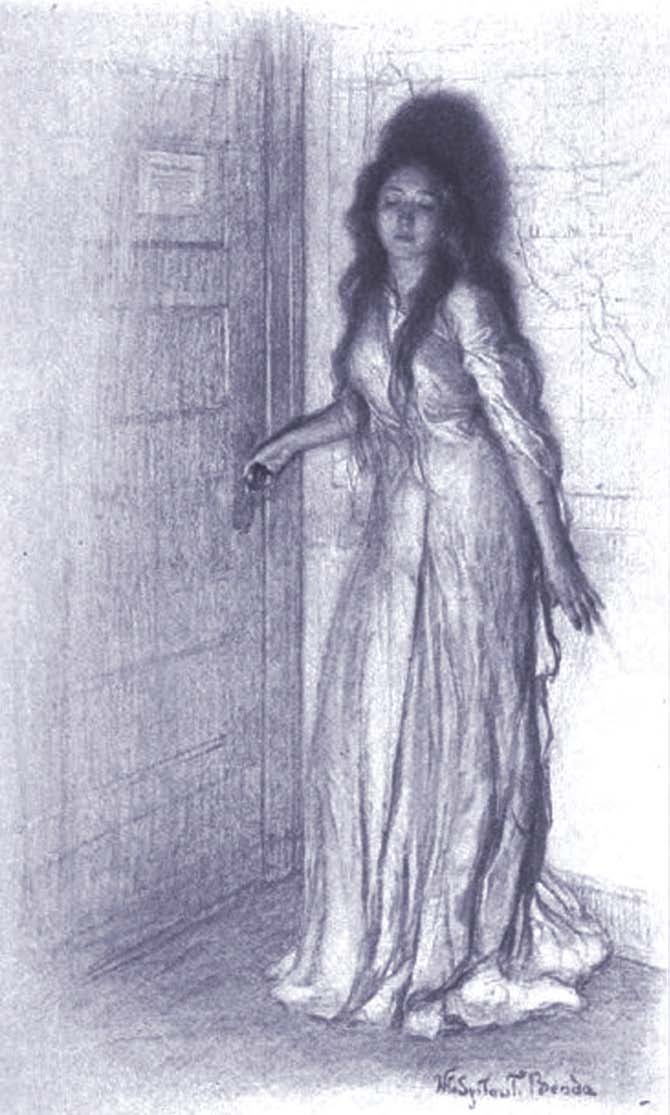
Author: Wladyslaw Benda
The summer after I graduated from college, days before I moved to New York City to launch a real adult life, I saw a ghost—an apparition, a spirit, an angel. Decades later, I am still not sure what to call it or where it came from. But I can still see her as if she appeared at the foot of my bed last night. And I never forgot what she told me.
It happened in the big old house my family moved to when I was fourteen years old, after my mother decided that our first house, a cozy brick ranch house designed by an uncle and largely built by my father, was no longer big enough. I was told the big house was a bargain because the previous owners were highly motivated to sell.
There was something gloomy and oppressive about the place. The kitchen was modernized but the rest of the house was full of dark wainscoting. The diagonal placement of the fireplace and the angles of the rooms were off-kilter so that doors didn’t shut tight. I left my bedroom door ajar because if I didn’t the old latch unlatched and the door creaked open in the middle of the night. Even my father, the most pragmatic and cheerful of men, admitted that the dark and narrow upstairs hallway felt “ominous.”
The front room upstairs, the former master bedroom, became my room. It had three huge windows that overlooked the street, so it should have been cheerful but it was the gloomiest room of all. It was dominated by a wooden bed with an elaborately carved headboard that touched the ceiling and a high footboard. It had big carved urns on top of the bedpost finials, and looked like the bed a literary character would sleep in—a young Dracula or Jane Eyre, as she listened to the strange sounds in Mr. Rochester’s mansion.
The family joked that the master bedroom was mine because I was the only one who fit the bed. Brackets had been added in the frame to fit a modern mattress but it was too short for anyone over five foot six inches or so, and that was everyone except me. But I also fit the bed because I was the most mystical, ethereal, dramatic. Like many adolescents, I harbored the sense that I was secretly capable of a greater life, and I cloaked this sense under a protective layer of darkness. If I was a teenager today, I would probably have adopted the style called “goth.” In those days, I was drawn to dark, brooding hippie poets like Jim Morrison.
Hoping to make my room a psychedelic sanctum seem completely separate from the rest of the house, I persuaded my father to bolt a three-foot black light to the ceiling. This plunged most of the room into darkness and cast certain things—anything white and the fluorescent paint in my psychedelic posters—in an eerie ultraviolet glow. I remember lying in that bed reading books like The Doors of Perception by Aldous Huxley and Siddhartha by Herman Hesse. I remember staring at a poster of Jim Morrison making a beckoning gesture, wondering how I would ever find my way into the magic inside life. In those days, there were no owls flying in to invite a kid to Hogwarts School of Witchcraft and Wizardry. I was sure it would take drastic measures, leaving home to be a wandering ascetic like Siddhartha perhaps, travel to remote nooks and crannies of the world, shaman guides, strange rituals and potions to lift me out of the confining shell of my little self.
The summer after I graduated from college, the black light and Jim Morrison poster were gone. But so was my inner confidence. Under all that high-school imagining there had been an intuition that glowed like white sheets under black light. I sensed that the truth could not be thought. It could not be conveyed by any verbal proposition or formula because it did not consist of fact. You perceived, received, felt the inner meaning of life. I wasn’t sure how, but I sensed that I was made for this.
After college, I brimmed with ideas but I no longer trusted or even knew how I felt. I planned to move to New York City, like someone numb with cold heading towards a distant fire. I didn’t know what I would find but I had to head towards life. I planned to stay with a college friend while I looked for a job in publishing. Neither the friend nor the plan was right for me. I realize now that my heart was full of foreboding. There was truth waiting that I didn’t want to let in.
The ancient Celts spoke of “thin places”—places where the boundaries between worlds, between day and night, sleep and waking, what is seen and unseen, is more porous. I decided the house might be a thin place. And looking back, I think I might have been a thin place too. Certainly it was a time when I was vulnerable to the unknown.
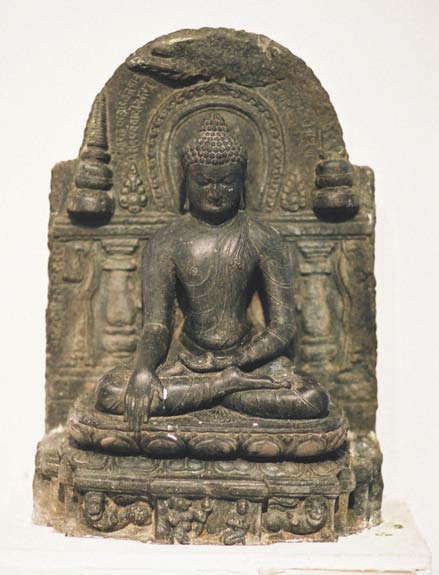
Author: Hyougushi
I awoke in the night with a start to see a young woman standing at the foot of my bed. She had long wavy hair and very fine features. She was very beautiful but seemed to be made of white mist, like a very fine sculpture made of dry ice. She was dressed in a long Victorian dress. To this day I can see the eyelets in the lace. She smiled at me and told me her name was Elizabeth. I remember gasping for breath. My heart raced and my lungs burned as if I was running hard, yet my legs felt paralyzed.
Years later, I learned that paralysis is common during ghostly encounters, as is this detail: I didn’t see her feet. It wasn’t just a matter of the high footboard. When people see ghosts, according to the paranormal researchers I interviewed, they don’t report seeing their feet. Most unusual was the way she looked directly at me and addressed me. Most ghosts are unseeing, literally haunted. And then there was her message.
Still smiling at me, she said, “I came to tell you that if you don’t want your body, there are others who do.”
A jolt of terror lit me up inside like fireworks. “No!” welled up from the depths of my being. My mind filled with entirely with one aim, one thought pushed out all other thoughts and unthinkable possibilities: “I want this body! I want this life.” There was a surge of energy, a fierce certainty that I would fight to the death for this life. My deepest instincts were rallying to my defense.
On the night the Buddha achieved enlightenment, he reached down and touched the earth, asking it to bear witness to his right to be there, sitting under that tree. It is traditionally taught that the Buddha was asking the earth to bear witness to his many lifetimes of seeking. But I believe he was also reaching down to claim his deeper nature, calling the whole of himself to the great task of awakening.
“Read the myths,” Joseph Campbell once said in an interview with Bill Moyers. “They teach you that you can turn inward, and you begin to get the message of the symbols.” It would be years before I encountered the symbolic act of the Buddha touching the earth as he faced the demon Mara. But it perfectly captured the sense I had of touching the earth of my life that night.
This pale messenger presented me with a reality beyond my wildest imagination. Her message exploded my sense of the possibilities and preciousness of my life. Suddenly, I was a resident of the world of the living, and something in my deeper nature—something that connected me to the whole of nature—rose to my defense.
For a time when I was a little girl, I had a black panther named Striker as an invisible friend. We would run and climb trees. Faced with imaginary enemies, we would crouch and pounce with cat-like grace. Striker was my own metaphor for joy and passion and embodiment. That night, without a single word intruding, I remembered what it means to be embodied. Our human truth is not separate from it. Understanding draws on the experience of standing under, receiving the truth that rains down on you and into you. In a flash of terror, I realized we may dwell in the midst of other worlds. But the meaning I was searching for was in me.
Still smiling, and speaking in a soothing voice, Elizabeth explained that she didn’t live in this house but nearby. She told me I could reach her if I needed her—and I had the impression that she meant she lived in the house next door. This proved wrong, which I will explain in a bit. Even now I can see how serene and light she looked as she backed away in that dark old house.
I don’t know how long it took me to peel my frozen limbs off the bed and run down the hall to wake my mother. My father was often away in those days. Gasping, heart pounding, I choked out what happened: “You might think I’m crazy, but I’ve just seen a ghost.”
“I don’t think you’re crazy,” she said. Inviting me to come sit next to her in the bed, she told me that one night when she had been alone in the big old house she woke up in the middle of the night to see a column of white fog hovering in the doorway. “It was so strange,” she said. “I’m the type who has to investigate so I walked towards it. I felt so cold and sad as I drew close, then it disappeared.”
In the days that followed, I heard other stories. A houseguest had reported hearing footsteps in the upstairs hall and a heavy scraping sound like a trunk being dragged across the attic floor. My parents came home from a month-long vacation and felt a presence in the house. “It was the strangest thing,” said my father. “It was as if someone wearing violet cologne had just left the room. Your mother and I looked at each other without saying a word, each of us sensing that someone was there.” I was the only one who saw an apparition.
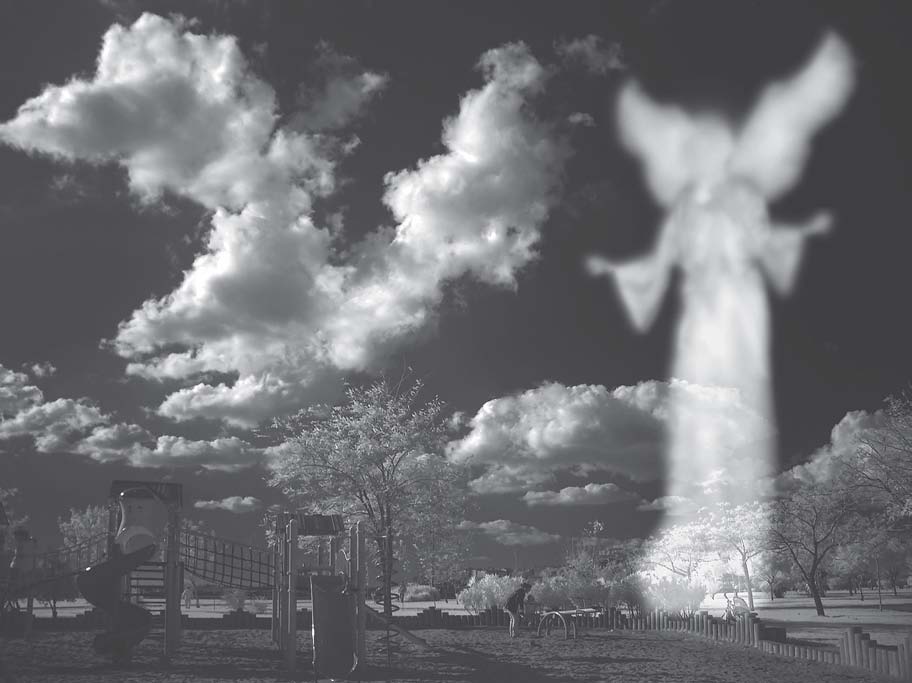
After that night, I couldn’t move to New York fast enough. I made a wordless vow never to speak of the experience or even think of it. But it trailed after me, a riddle I hadn’t completely understood. I worked in publishing, then in the movie business, and finally I became a writer—always striving in the same spirit of drawing closer to the fire, seeking a more vivid experience of life.
Not long after I moved, my parents sold the house (for a song, they said). Sadness and mishaps befell the new owners, who sold the house to others, who also came to grief and sold the house. My mother speculated that there was something sinister about the place. It was often for sale. Recently I visited my hometown and saw the sign was up again.
At what I thought was a safe distance and in good company, I sometimes allowed myself to feel what happened. Friends sometimes asked me if I thought the apparition might be a guardian spirit or angel. Wherever she came from, some other dimension or the depths of my own psyche, maybe she came to help.
A decade after I saw Elizabeth, I left corporate life to be a freelance writer. I moved from the Upper West Side to the gritty East Village, so the fire I drew close to turned out to be the trash can fires the winos lit around Tompkins Square Park. But I felt bohemian and brave. New York Magazine gave me an assignment to cover a séance that was held regularly on the Upper West Side. I sat in a comfortable living room, watching as intelligent-seeming people sought guidance from a man who went into a trance to purportedly channel wisdom from an ancient being. I was convinced the man was a fraud, and I tried to ask probing questions to try to prove it.
“I have a question for you,” said the man, when he came out of his trance. “Who is Elizabeth? In the atmosphere all around you, I hear the name Elizabeth.” All my bright questions blew out.
A few years later, I received an assignment from a now defunct science and science-fiction magazine called Omni, to write about how researchers use the methods of science to track down ghosts. I leapt at the chance. In addition to interviewing paranormal researchers and skeptics and doing research, I visited the scene of a few hauntings and paranormal investigations. One was a rambling apartment on Washington Square. As I sat at a kitchen table drinking coffee, “Kathleen” (she didn’t want her real name used in the article) described what happened to her one night in October 1973. She told me she heard the front door slam. Thinking it was her sister, preoccupied with the dinner party they had planned, she rushed happily towards the door. In the dusty rose-colored hallway she froze and all the happy images in her mind went dark.
“There was a hunched-over figure in a black robe,” said Kathleen (I quote from my 1988 Omni article). “I thought it was a robber, though it seemed very sick or old.” She turned on the light and watched the figure creep toward the bathroom down the hall. She called to her mother who was in her bedroom up the hall, asking her who just entered the apartment. “Nobody,” her mother answered. “It was almost as if the figure was absorbing light instead of reflecting it,” the woman told me. “But even then, I never thought of a ghost.”
The following night Kathleen looked up from the sofa to see her mother standing in the doorway shaking. She told Kathleen she had heard a whooshing sound in the hall and looked up to see a “transparent blackness” passing down the hallway towards the bathroom. She yelled “Kathleen! Kathleen!” and ran after the shadow, only to find nothing there. Soon enough Michaeleen Maher, a family friend with a Ph.D. in parapsychology, heard about these incidents. Equipped with a Geiger counter, infrared photography equipment, and a team of volunteers, Maher attempted to use the tools and techniques of science to investigate. The results were suggestive but maddeningly elusive in scientific terms. There was a “parabola of fog” in an infrared photo of the hallway, and a flurry of Geiger clicks in a particular spot, but nothing that could not be ruled out by ordinary explanations.
I remember sitting with Kathleen and Maher in the kitchen of that apartment on Washington Square. In the years after the haunting, Kathleen became an accomplished photographer and her smoky, evocative photos lined the walls. She, Maher, and I studied the infrared photo with the parabolic arc of fog. They pointed out a dark circle.
“To me it looks like a black face up close to the camera,” said Kathleen. Mayer said that one of the psychics she brought in reported seeing the figure of an African American. Kathleen and Maher acted out how the mysterious figure moved up the hall. The tour ended in her late mother’s room and a window overlooking Washington Square Park. What Kathleen explained next shifted my perspective for good.
Directly across the street from the window stood a massive old elm tree. Kathleen said that according to her research, the last person to be hanged in New York City was hanged in that tree. She was an African-American woman who worked as a servant in one of the grand buildings lining the park. The conversation rushed on: Kathleen saying that ghosts open up a world of forces and influences science can’t understand; Maher suggesting that someday science may have tools fine enough to collect physical evidence for such phenomena.
I kept thinking of that servant, hanged for stealing. I wondered if there might be situations so grave and critical they are impressed on us—and on the world we live in—by extraordinary means.
I learned there many cases of haunting seen by hundreds of people—the Allied landing at Normandy on D-Day is one. I wondered if we were asking the wrong questions, looking at the experience in the wrong way. Maybe the focus should be shifted from a ghostly messenger and where she came from and turned back to the one who perceived the experience. Suddenly, I found it amazing that we humans are capable of such perceptions. We were larger than we knew.
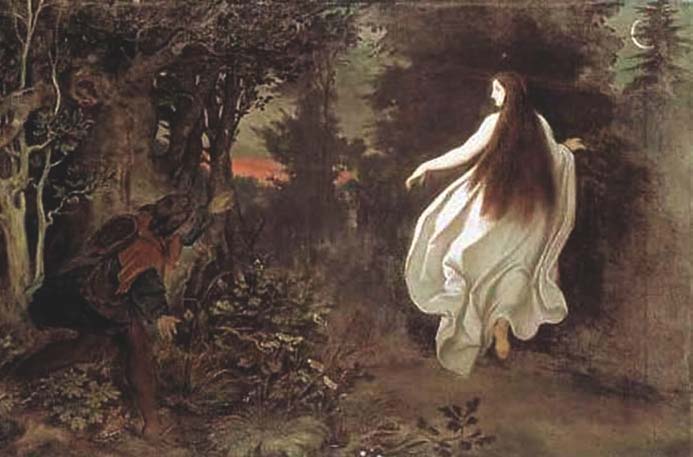
Schwind, 1858
I was certain of the reality of my experience. Yet I also came away siding with the skeptics. As Ray Hyman, professor of psychology at the University of Oregon, explained to me, even the most rigorous of these investigations “are historical investigations, not true scientific investigations at all.” It all comes down to testimony, stories. No researcher has ever been able to capture a ghost by way of an experiment that can be repeated in a lab.
“Not till we are lost, in other words, not till we have lost the world, do we begin to find ourselves, and realize where we are and the infinite extent of our relations,” wrote Henry David Thoreau in Walden. Science could tell me nothing about my experience. Very slowly, it dawned on me that its meaning might arise in the space between extremes of affirmation and denial. It might come to me in the midst of my life as I lived it, slowly opening over time like the meaning in a story or a myth.
My article on modern-day ghost hunters became a front page story, and I was invited to participate in an experiment in a famous haunted location—an experiment that was later re-enacted in a television show called Unsolved Mysteries. In an attempt at scientific purity, I was told nothing about where I was going or what exactly I was going to be doing, only that a group of us would be leaving after dark and spending the night.
I remember standing outside my apartment in the East Village in downtown Manhattan, alive with uncertainty and anticipation. As I watched the punk kids, artists, and all the other members of the wild and raggedy East Village scene pass, I registered that I didn’t know what I was meant to do here on earth, that probably few people did. But I sensed it had something to do with bearing witness to the life I was given to live, with really digging into it and learning what there was to learn. Although it would take years to let this truth soak in, I realized that night that we are meant to follow the flow of our lives, to be with our embodied experience in all its imperfection—but also to turn our attention to the one who knows.
In the van with parapsychologist Maher and others, I learned that I was to be a control in an experiment that involved leading a group of psychics through the General Wayne Inn in Merion, Pennsylvania. Established in 1704, the inn was legendary for being haunted by numerous ghosts, including a handful of Hessian soldiers. George Washington slept there, as did Benjamin Franklin. Edgar Allen Poe was a frequent visitor and carved his initials in one of the window sills in 1843. A dozen years after my overnight stay, a subsequent owner of the inn was found murdered in his office. The killer turned out to be his business partner.
My job was to sit for hours on the cellar steps. One by one, the psychics were led from the attic to the basement like blood hounds. Backs turned to me, facing the shadowy wine cellar, several psychics gasped or murmured that they sensed something. One, a celebrated Manhattan psychic, later reported that she saw Hessian soldiers crouching and felt their terrible fear. Yet in spite of this uncanny confirmation, the investigation was scientifically inconclusive.
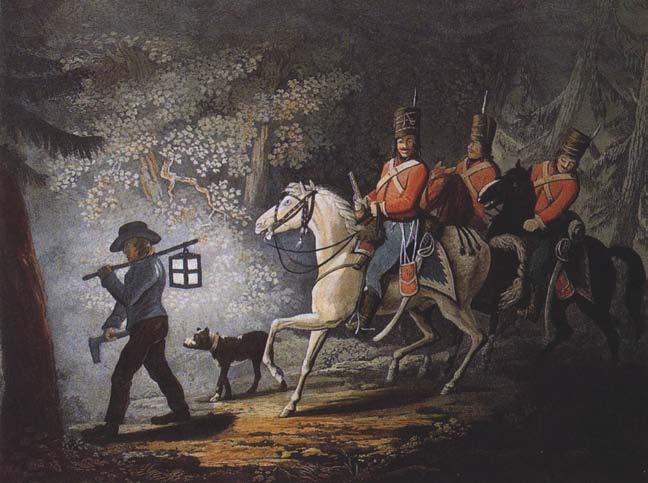
Gessner, 1799
As the sky grew light, everyone in the search party gathered in the bar. The manager and bartender offered us coffee and drinks. They liked my Omni article and agreed with its skeptical conclusion. I marveled that I had sat much of the night in the basement, unable to sense the presence of any of the unknown forces around me. What I didn’t tell them was that it had felt strangely peaceful and intimate. I remember sitting there breathing, registering that I was alive, in my body and breathing, and yet I wasn’t as fully alive, not as sensitive and aware, as I could be. A new kind of questioning dawned that would take years to break the surface of consciousness. I came to understand that there was another kind of investigation to be done—not outside but inside.
If you don’t want your body, there are others who do. I once heard that the Indians of North America thought that the invading European settlers were possessed by the wendigo, a malevolent, flesh-eating spirit that took over their bodies and drove them to consume the lives of others, to consume the earth. I began to see how easily we can lose our sense of being embodied in this world in normal circumstances—taken over by the spirits of anger, fear, righteousness. I realized that it is very easy to lose your life before you die.
Over the years, the warning Elizabeth uttered rained down, soaked in, led me to understand a truth that is situational, personal, perceived in the moment. The angel, the ghost, the spirit that is Elizabeth showed me that the experience of embodiment leads us back to the marvel of perceiving and the mystery of the one who knows. She showed me that the richer, deeper life I longed for when I was young is available here and now in the vulnerability and imperfection of this body in the present moment … if I want it. ♦
From Parabola Volume 37, No. 4, “Science & Spirit,” Winter 2012-2013. This issue is available to purchase here. If you have enjoyed this piece, consider subscribing.
